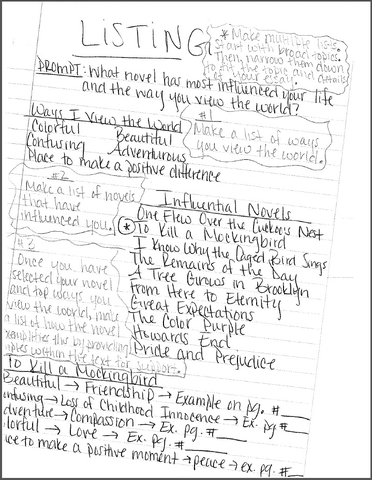Prewriting is an important step in the writing process. Fully exploring your ideas and planning out how they will take shape in your paper will ensure you are able to achieve your purpose. Depending on your learning style, some prewriting strategies may work better for you than others.
One common prewriting method is listing, which complements kinesthetic, reading/writing, and visual learning styles.
How do you list?
Listing is a strategy writers use to brainstorm and write ideas about their chosen topic as they come. Usually, writers will place each individual point or idea on its own line, either on loose-leaf/notebook paper or in a Word document. The ideas are meant to be unstructured and do not have to be listed in any particular order but can be if that is helpful to you.
Keep in Mind:
- Listing is not restricted to either complete or incomplete sentences. You can use individual words, phrases, or whole sentences.
- Listing can be done on the computer. However, experts have found that pen on paper is a stronger memory enhancer than typing on a computer, so listing is best done by hand (Smoker, Murphy, & Rockwell, 2009). The information you list can include ideas, facts, points, topics, etc. Be as detailed as is helpful for you. There are no limits!
- Lists can be bulleted, numbered, or just placed on separate lines. You can even make your list hierarchical if that works for you. There are no rules!
- Listing is very fluid and can be a continued process (you can keep adding to your list as you continue through the writing process, or generate new lists that build on one another).
- Giving yourself the cue from your prompt can help you get started.
- Planning on doing multiple lists will help you stay organized when writing your paper, and will allow you to break up your ideas into more manageable sections.
Why should you list?
- Listing helps you see what you already know about your topic.
- Listing identifies gaps in your knowledge that you should research later.
- Listing can help generate subtopics. These subtopics can expand or narrow your topic.
- Listing is more structured than just freewriting. The points are not ordered, but they are separated from each other.
- Listing helps you get your ideas out quickly on the page, which can then allow you to focus on other aspects of your paper, or start to see relationships between the points you’ve written out.
Example List

Text in image:
Make Multiple lists. Start with broad topics. Then, narrow them down to fit the topic and details of your essay.
Prompt:
What novel has most influenced your life and the way you view the world?
#1: Make a list of the ways you most view the world.
Ways I View the World:
- colorful
- beautiful
- confusing
- adventurous
- place to make a positive difference
#2: Make a lit of novels that have influenced you
Influential novels
- One Flew Over the Cuckoo's Nest
- * To Kill a Mockingbird
- I Know Why the Caged Bird Sings
- The Remains of the Day
- A Tree Grows in Brooklyn
- From Here to Eternity
- Great Expectations
- The Color Purple
- Howard's End
- Pride and Prejudice
#3: Once you have selected your novel and top ways you view the world, make a list of how the novel exemplifies this by providing examples within the text for [?]
To Kill a Mockingbird
- Beautiful > Friendship > Example on pg. # _
- [?] > Loss of Childhood Innocence > Ex. pg # _
- Adventure > Compassion > Ex. pg #_
- Colorful > Love > Ex. pg #_
- [?] to make a positive moment > peace > ex pg #_
Tips:
- This student began with the ways in which they view the world. Then, they moved on to influential novels they have read. Lastly, they combined those two lists by determining specific examples from the novel that influenced their worldview.
- Planning on doing multiple lists will help you stay organized when writing your paper, and will allow you to break up your ideas into more manageable sections.
- After you’ve created your list, go back over it! Check and see what you like or dislike about your findings. If you think something is particularly interesting or worth pursuing, note that through a star or check or some other notation.
Smoker, T. J., Murphy, C. E., & Rockwell, A. K. (2009). Comparing memory for handwriting versus typing. Proceedings of the Human Factors and Ergonomics Society, 53(22), 174-1777. doi: 10.1518/107118109X12524444081755


